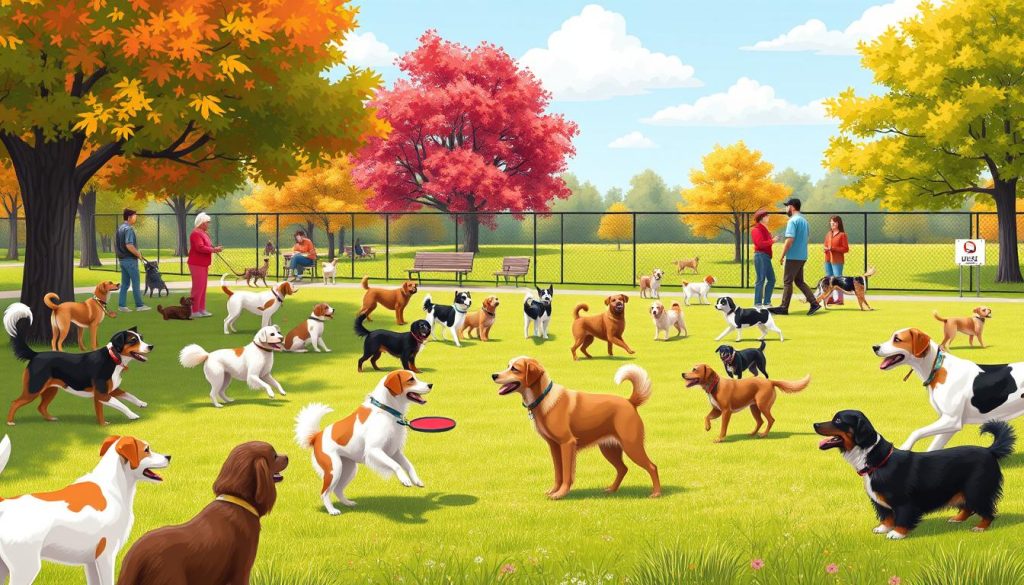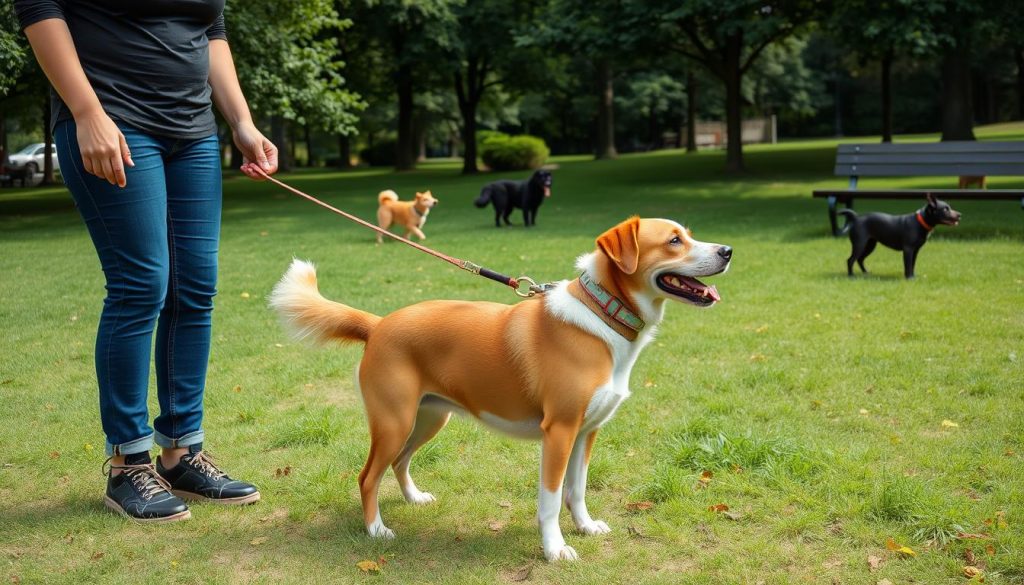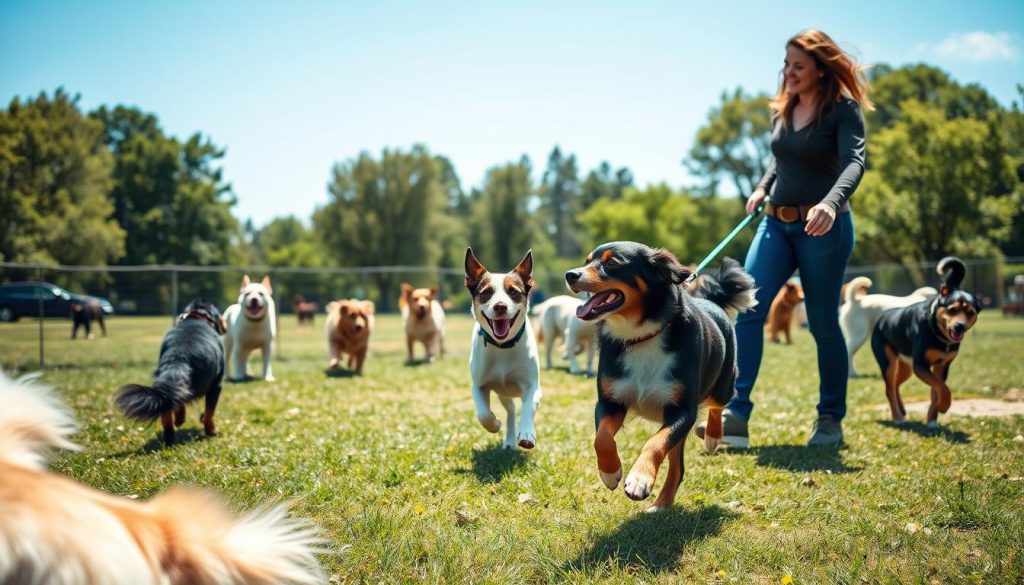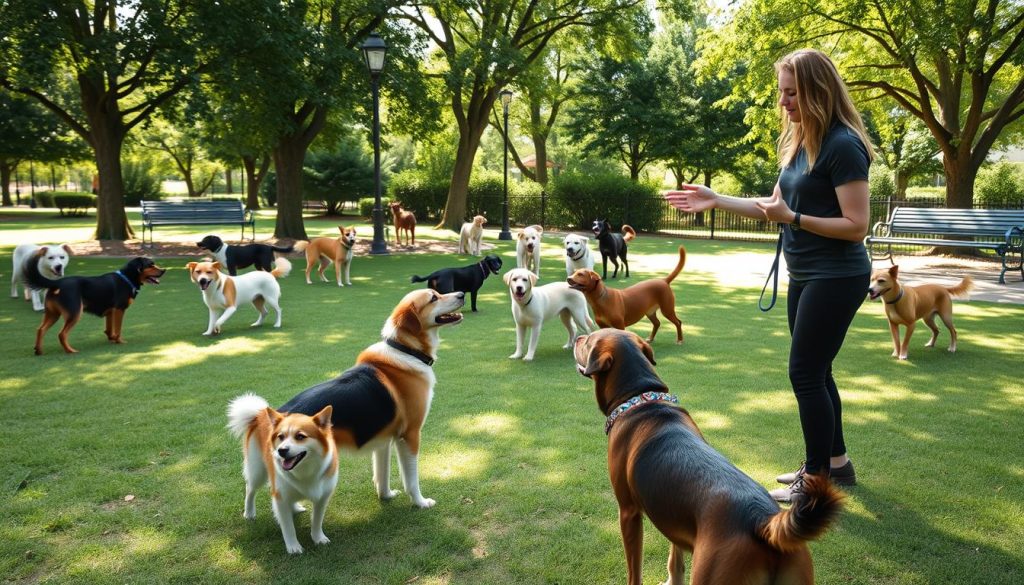Do you ever wonder if your dog can handle the dog park’s complex social scene? It might seem tough, but with the right training, your dog can shine. They’ll become a perfect example of good dog park behavior.
Start training your puppy early, around 7 to 8 weeks old. Keep the first sessions short, just 5-10 minutes. But, being consistent and positive is key. Teaching them to sit, stay, and come is crucial for their obedience at parks.
Even older dogs can learn quickly, in about four weeks with 15-20 minute sessions. This shows how adaptable and capable our pets are, no matter their age. By teaching them to behave well, you make dog park visits fun and safe for everyone.
Introduction to Dog Park Etiquette
Understanding dog park etiquette is key. By following dog park rules, you make the park safe and fun for everyone. It’s important to watch how your dog interacts with others to prevent bullying or rough play.
Make sure your dog is up to date on shots like bordetella and canine influenza before going to the park. Dr. Jerry Klein suggests using flea, tick, and heartworm prevention. Puppies under four months should not meet unknown dogs to avoid health risks.
Teach your dog basic commands before taking them to a dog park. Dogs that are reactive or aggressive might not do well in dog parks. Instead, try activities like obedience classes or dog sports to keep them happy.
When you’re at the park, clean up after your dog and don’t bring personal items. This helps avoid fights. Watch your dog closely and step in if they start to fight. Limit visits to 30-60 minutes to prevent your dog from getting too tired.

Quick Recommendation : Our blog is filled with tips , tricks, and methods for training your dog. If you would like to attend a Free Dog Training Workshop, we recommend the K9 Training Institute , give it a try.
The goal is to make sure all dogs have a good time. By following dog park rules, you help create a positive environment. With careful management, dog parks can be a great place for your dog to play and socialize.
Leash Training Basics
Leash training is key for dog owners who want to take their pets to the park. It’s important for controlling dogs on leash, both inside and outside the park. This helps avoid problems like tugging, lunging, and leash aggression.

Quick Recommendation : Our blog is filled with tips , tricks, and methods for training your dog. If you would like to attend a Free Dog Training Workshop, we recommend the K9 Training Institute , give it a try.
Many places have leash laws to keep everyone safe. Breaking these laws can lead to fines or citations. Dogs can get lost, hit by cars, or get into fights if they’re off-leash.
Training consistently is crucial for better walking behavior. Dogs may jump and mouth treats at first, but they learn to stop after a while. Regular training and fewer treats help them walk better.
It’s also important to manage your dog’s energy. Draining their energy before training makes them easier to control. Hunger can also motivate them to behave well.
Dealing with leash problems is common. Over 88,000 people have looked for help with their dogs’ naughty behavior. With the right training, walks can be enjoyable for both you and your dog.
Reliable Recall: What It Is and Why It’s Important
Training dog recall is key for safety and control, especially in places like dog parks. It means your dog will come back quickly, even with distractions. This gives you peace of mind when you’re out with them.
To get reliable recall, use good training methods. Begin with short sessions, five to ten minutes, for puppies. Use treats like chicken, cheese, or beef liver to make commands more appealing.

Quick Recommendation : Our blog is filled with tips , tricks, and methods for training your dog. If you would like to attend a Free Dog Training Workshop, we recommend the K9 Training Institute , give it a try.
Being consistent is important. Mix recall training into daily routines like meals or playtime. As your dog gets better, add more distractions and longer distances. Reward them with treats and praise, then praise alone to make them respond well always.
Avoid making recall cues negative. If needed, use a new cue to keep training positive. A long leash can help practice recalls safely at a distance.
Different dogs need different training. Positive reinforcement works better than shock collars. It leads to quicker learning and better responses. Using these methods will make dog park visits fun and worry-free.
Training Your Dog to Behave at the Dog Park
Teaching your dog to behave at the dog park is a big challenge. Basic commands like “sit,” “stay,” “come,” and “leave it” are key. They help keep control and ensure safety. It’s not just about obedience; it’s also about creating a calm place for all dogs to play.
Start training at home and then move to other places before the dog park. This helps your dog get used to different settings. They learn to follow commands even when there are distractions.

Quick Recommendation : Our blog is filled with tips , tricks, and methods for training your dog. If you would like to attend a Free Dog Training Workshop, we recommend the K9 Training Institute , give it a try.
Rebecca Ruch-Gallie, DVM, says leash training is crucial. It helps dogs stay fit and social. Always watch your dog to avoid fights and step in if needed. If your dog misbehaves, leave the park right away to teach them good behavior.
Use treats wisely, especially at first. This helps your dog learn without becoming too dependent on them. When your dog responds well to commands at the park, they’re a joy to be around. This makes the park a better place for everyone.
The Importance of Sit and Stay Commands
Teaching your dog to sit and stay is key, especially in places like dog parks. These commands help keep your dog safe and prevent accidents. They are basic but very important.
Science shows that rewarding your dog works best, as Dogs Trust points out. This method is great for teaching sit and stay. It builds your dog’s confidence and encourages them to think for themselves. Begin training in a quiet place, like your living room, to keep things calm.
Using treats is a must for teaching your dog to sit. Hold a treat to lure them into a sitting position. Say “sit” while they do it, then reward them. As they get better, move training to places with more distractions.
Training your dog to stay means teaching them to stay still for longer. Start with short times, say “stay,” and reward them for staying. With regular practice, your dog will learn to stay calm in busy places.
Keep training sessions short, about 10-15 minutes. This keeps your dog focused. Use treats, toys, or praise to motivate them. Consistent training and positive feedback will help your dog learn these commands well. This way, they’ll behave better in dog parks and other busy areas.
Teaching Drop It and Leave It Commands
Learning the drop it command and leave it command is vital for controlling dog behavior. This is especially true at the dog park. Dogs often want to pick up and eat trash or dead animals. Teaching them to drop it early can stop this before it starts.
Trying to take something from a dog can lead to biting. It can also make them guard their things more. But, teaching them to drop it makes playing fetch and learning tricks easier. Using treats or their favorite toys helps them learn this command well.
Training in different places, like cities and countryside, needs to be consistent. Owners might feel upset if their dog doesn’t listen at the park. Using fun activities like tug-of-war keeps training exciting. Giving treats or toys after they drop it helps them learn faster.
Practicing often is important, and starting early is best. But, you can still teach your dog new things even if they’re older. Always have treats, a toy, and maybe a clicker ready to keep training safe and fun.
Tips for Training in Different Environments
Changing where you train your dog is crucial for their reliability and obedience. Start with simple places and then move to more challenging ones. This helps your dog learn to adapt and respond well in any setting.
Before going to a busy dog park, test your dog in a calm place like dog daycare. This helps you see how they handle being with other dogs. It’s important for their safety and happiness at the dog park.
Not all dogs do well in crowded places. Some might get scared or act aggressively. It’s important to watch your dog and know when they’re stressed.
Start training in quiet places and then add more distractions as your dog gets more confident. Paying attention to your dog’s body language is key. It helps you know when they’re feeling stressed or uncomfortable.
Also, avoid bringing toys or treats to the dog park. They can make dogs compete with each other. Instead, use commands like “come” to keep them focused. By training in different places, your dog will learn to stay calm and listen, even with distractions around.
The Role of Treats and Rewards
Using dog training treats is crucial for successful training. Start with high-value treats to grab your dog’s attention. This makes them more likely to follow commands. Using tasty treats during training boosts their motivation and engagement.
Positive reinforcement is a strong tool in dog training. Start with treats, then move to praise and petting. This method consistently reinforces good behavior. For example, giving a treat when your dog calmly approaches others solidifies this positive action.
Training in different places with distractions helps your dog stay focused. Use a longline for better control, especially for basic commands. This keeps your dog attentive and responsive.
Don’t punish your dog for bad behavior at the park. Keep training positive to ensure your dog responds well. Treats make training enjoyable and encourage good behavior.
Maintaining Calm and Control
Keeping your dog calm and in control at the dog park is key for safety and fun. Good calm dog training stops over-excitement and aggression. These can happen when dogs are too excited or stressed.
Try U-turns away from other dogs and walking exercises outside the park. These help your dog stay focused on you and reduce stress. It’s important for handling dog behavior in real life.
Playing with your dog away from the park makes them happy to be with you. This builds good behavior. Recall training in a quiet place helps your dog listen, even with distractions.
Games like the Engage/Disengage game or Cookie Toss game help your dog stay calm. These games, with regular practice, keep your dog under control. This makes the dog park a better place for both you and your dog.
Stay calm yourself, as your dog will too. Use clear commands and know when to leave a busy situation. Socializing with other pet owners makes the experience better, creating a friendly community.
Remember, calming supplements before play and spaying or neutering can prevent unwanted interactions. By following these tips, your dog will stay calm and safe at the dog park.
Common Pitfalls During Dog Park Visits
When you take your dog to the park, knowing common mistakes is key. It’s important to avoid dog conflicts by teaching them to be polite. This helps prevent fights.
Also, always watch your dog closely. Not doing so can lead to fights or bad behavior. Don’t bring a dog in heat, as it can make other dogs aggressive.
It’s a big mistake to mix small and big dogs in the same area. Big dogs might see small ones as prey, which is dangerous. Make sure small dogs have their own space to play safely.
Don’t pick up small dogs when things get rough. It can make other dogs more aggressive. Make sure your dog is tired before going to the park to avoid too much energy.
Teach your dog to come back to you quickly. This is important for their safety and yours. Always follow the park’s rules and clean up after your dog. This keeps everyone healthy and happy.
Finally, watch your dog’s behavior closely. If they seem upset or aggressive, take them away right away. This keeps the park a safe and fun place for everyone.
Conclusion
Proper dog park training and responsible dog ownership make visits safer and more fun for everyone. About 15-25 percent of dogs worldwide are “homed” individuals. Less than 0.5 percent of play fights turn into real conflicts. This shows how important good training and watching are.
Knowing dog park rules is key for safe visits. This includes keeping dogs leashed until the gates are locked and cleaning up after them. It’s also important to watch for aggressive behavior and respect other dogs’ space. Rules like separating small and large dogs and keeping unaltered or sick dogs out help keep things safe.
Every dog is different, so it’s important to know what they need. Make sure they drink water, watch for stress signs, and don’t bring food. Dog parks can be great places for dogs and their owners to have fun. By following these tips and understanding dog behavior, you can make dog park visits enjoyable for both you and your dog.
Quick Recommendation : Our blog is filled with tips , tricks, and methods for training your dog. If you would like to attend a Free Dog Training Workshop, we recommend the K9 Training Institute , give it a try.

